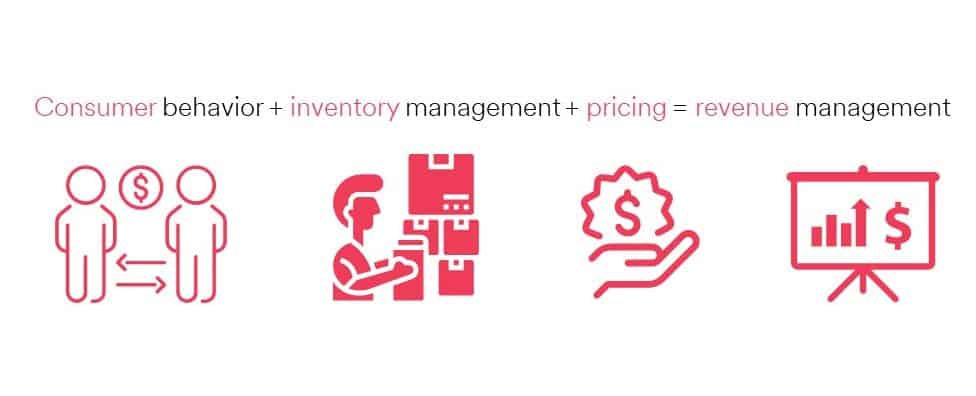What is Revenue Management?
- Revenue management is the business discipline that predicts consumer behavior at the micro-market levels and optimize product availability and price to optimize and/or maximize revenue
- There are several components to revenue management: product + customer + timing + pricing.
- The goal of revenue management is to align all four in such way that it would maximize revenue.
- Revenue management is mostly common within B2C industries, such as hospitality, airline and retail, however some of revenue management principles can be applied to B2B industries with large number of SKUs and complicated supply chain.
- To align the four components of revenue management, revenue and operational management teams require data-driven analysis of consumer behavior, inventory management skills and pricing strategy in place.

Pricing has been traditionally considered one of the levers for revenue management. However, we think that the power of pricing has been underestimated. Making a value-based pricing strategy the central pillar of the revenue management practice makes sure the revenue is not only optimized but also maximized.
Steps for establishing a value-based pricing strategy that maximizes revenue:
- Consumer research and data mining to understand customer perception of product value
- Pricing analytics to build customer segmentation
- Pricing tool/algorithm that uses inventory levels, elasticity, and iterative feedback to generate daily optimized prices over one inventory cycle.
- Workshops with heads of internal divisions (revenue, marketing, sales, operations) for strategic alignment
Examples of various pricing strategies that maximized revenue:
Dynamic pricing
Dynamic Pricing for an Online Retailer, Case Study:
- Designing the Analytical Model
- Scaling and Testing the Dynamic Model
- Implementing Price Recommendations
For the test category, the dynamic model was able to generate a 6% margin improvement over current pricing practices. The improvement was driven by a simultaneous increase in revenue (through more reactive pricing) and a decrease in costs via a 48% reduction in material waste.
Subscription pricing
Building a Subscription-Based Model for Software, Case Study:
- Develop Value and Pricing Hypotheses
- Conduct Market Research
- Develop New Pricing Strategy
The customer research that Pricing Solutions conducted revealed that over 75% of customers would be open to a new subscription model. The recommended subscription model offered a potential 18% increase in revenue per customer over 4 years.
Promotional pricing
Understanding the Impact of Promotions & Price, Case Study:
Built a comprehensive and tailored Pricing and Promotional Planning Tool (P3T):
- Leveraged existing POS data & could be continually updated
- Forecasted Volume & Margin for various price, product, and brand combinations
- Took into consideration the impact of seasonality, consumer preferences, shelf location, etc. and could isolate these factors if needed
- Model re-created actual incidence rates with 94% accuracy
Identified over $3 million in profit opportunities at one major retailer.





